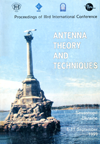Modelling of printed antennas arrays for various applications
DOI:
https://doi.org/10.1109/ICATT.1999.1236105Abstract
The design of printed antenna arrays follows mainly two rules which are: first the choice of the elementary source and secondly the choice of the architecture of the array itself. At each stage the constraints of SWR, polarization, frequency bandwidth, the required patterns, the feeding network…need choices between conflicting requirements. Moreover the flexibility of the printed technology offers the possibilities of innovative radiating structures well suited to these various systems requirements (frequency, bandwidth, gain, size, patterns...). The paper shows first various printed sources developed in the Antenna Laboratory and classified through their band-width (from few % up to 50% or more). The mutual coupling is a strong constraint for large bandwidth array but can be neglected in many cases when the distance between elements is large enough. Then different array architectures are presented for different kinds of patterns and bandwidth. Some of the arrays have received applications: for instance dual beam Doppler radar for accurate measurements of speed [1].References
DUPUIS, P.; DANIEL, J.P.; ALANIC, J.L. CRITT-CNRS French Patent No. 8712579P. Antenne plaque microonde notament pour Radar Doppler.
MOTTA CRUZ, E.; DANIEL, J.P. Modèle d'Antenne Carrée Imprimée alimentée en Coin: Application aux Réseaux Linéaires. JINA-90, November 1990, Nice, France, pp. 297-300.
COLOMBEL, F. Antennes à double polarisation et large bande. Application aux réseaux. Doctor Thesis of the University of Rennes I Janvier 1996, Rennes, France.
BOGUAIS, M. Contribution à la Synthèse de Réseaux d'Antennes; Réalisations en Technologie Imprimée. Doctor Thesis of the University of Rennes I October 1986, Rennes, France.
POEY, P.; BEGAUD, X. Electromagnetic analysis of dual polarized wide band antennas and arrays. PIERS, 1998, p. 13-17.

